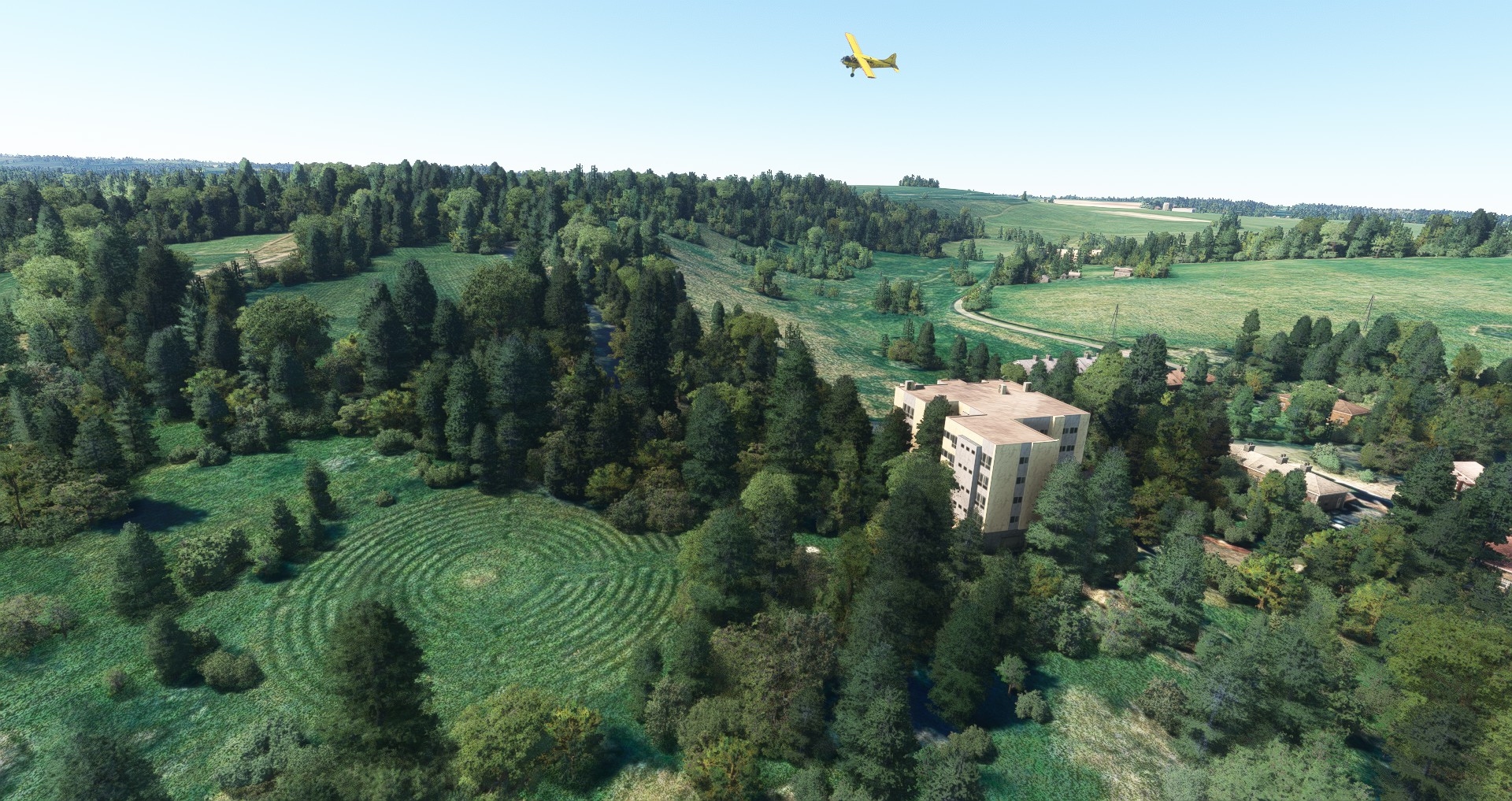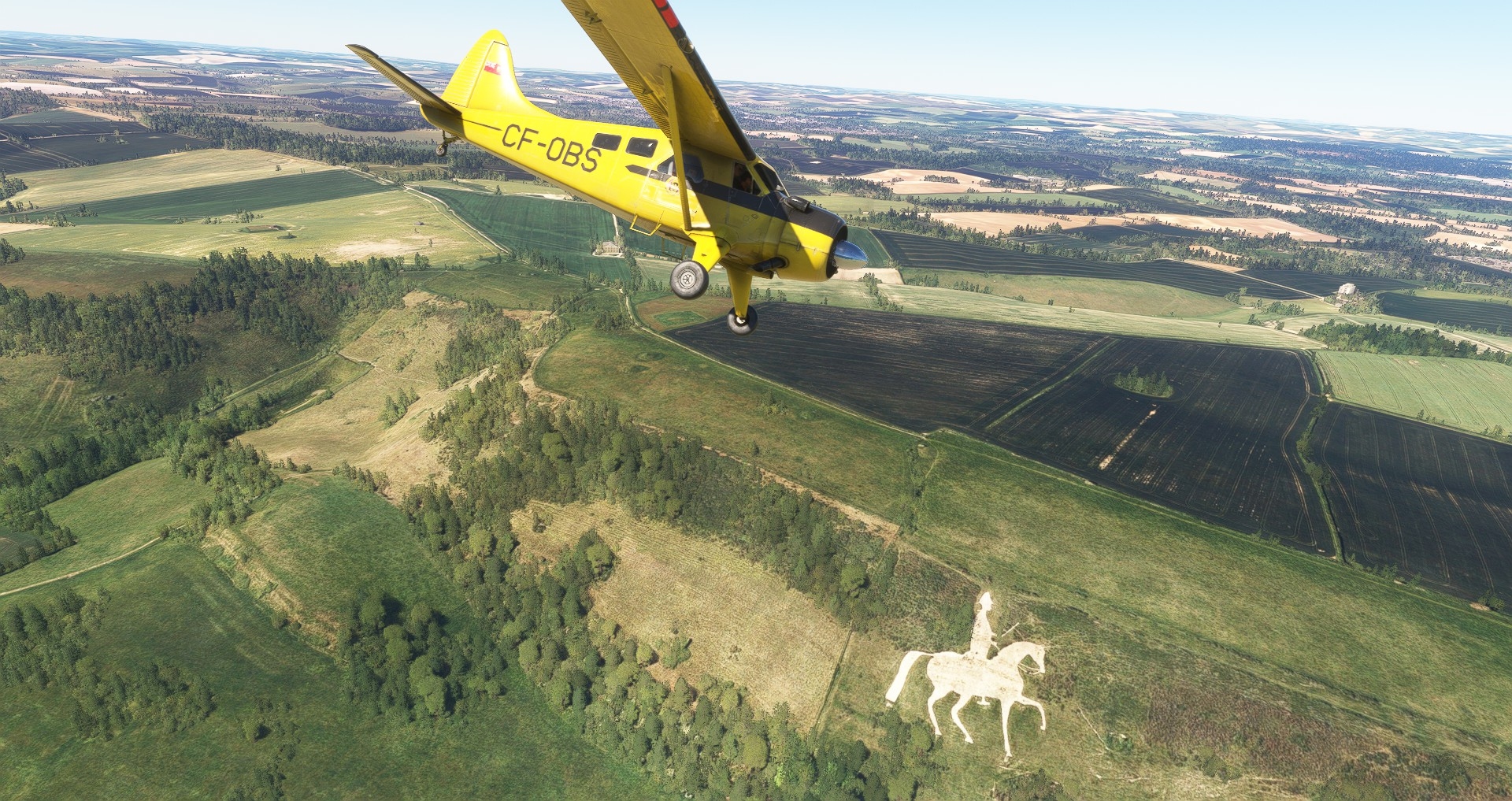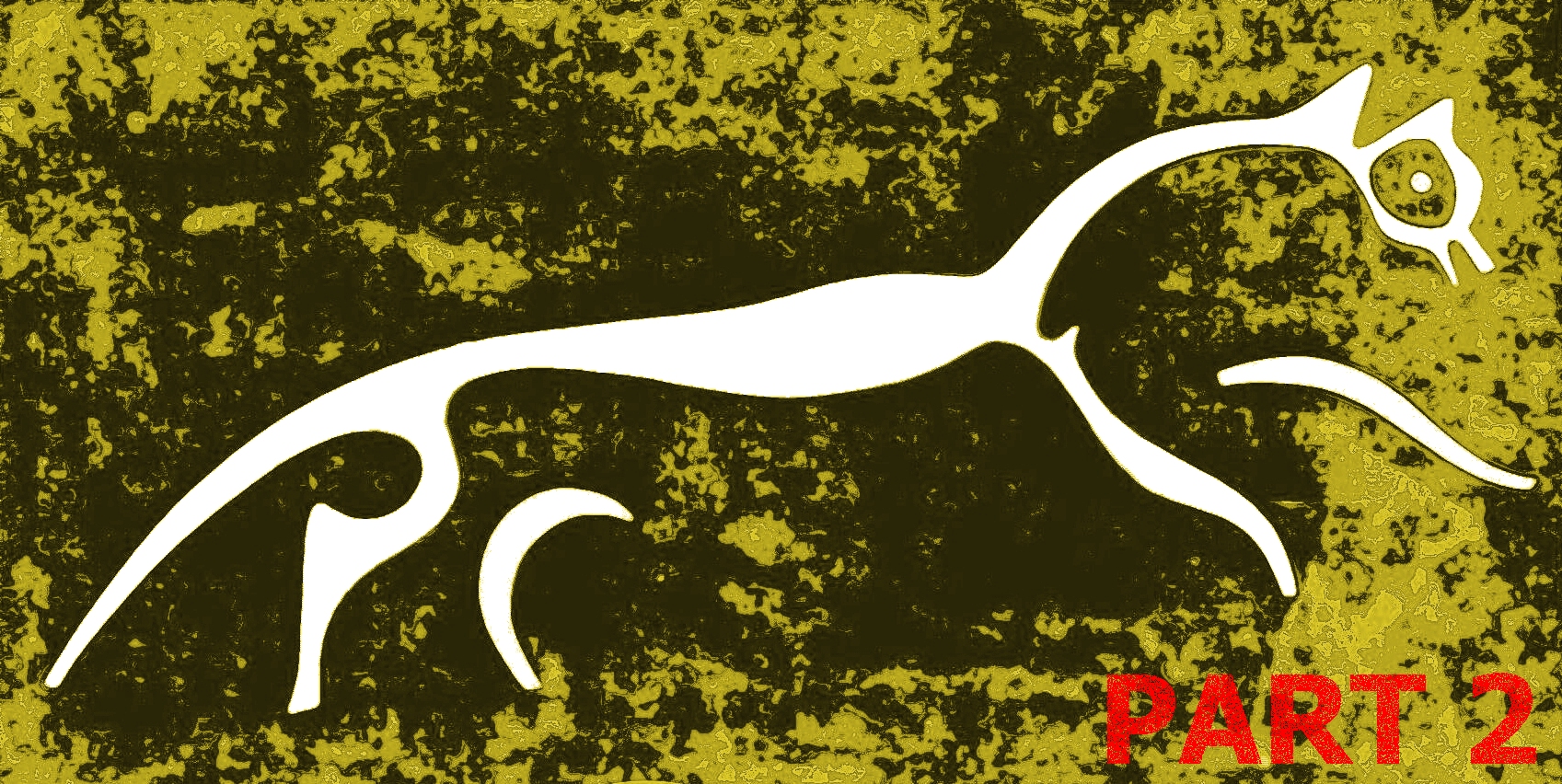Last Friday the first FS2020-powered Tally-Ho Corner air tour bimbled from the Uffington White Horse in southern Oxfordshire to the Bulford Kiwi on the south-eastern fringe of Salisbury Plain. Today we head for the Jurassic Coast, following a flight path that ropes together more huge hill figures and tourist-sprinkled history hotspots.

Beyond the ridge on which the Bulford Kiwi reclines, the Devon-bound A303 wends. For the next minute or two Roman wont need his GPS as all he has to do to find England’s best-known druid magnet is shadow this holiday highway westward for a few miles.

Before we reach Stonehenge, we overfly a vast organic battle memorial. Those seemingly random groups of mature beech trees down there are the Nile Clumps – what remains of a Nineteenth Century aristocrat’s novel tribute to Nelson’s victory at the Battle of the Nile. Each clump represents a different vessel in the duelling British and French battle lines. Together the clumps serve as an informative dendro-diagram – a record of fleet dispositions at the height of the scrap.

Somewhat oddly, Asobo’s version of Stonehenge is screened from the A303 by patches of completely fictional woodland, and isn’t thronged by underwhelmed and overcharged tourists. What’s that, Roman? You recommend fit/mobile visitors avoid English Heritage’s exorbitant entrance fees by parking at a nearby spot such as Woodhenge or Larkhill and walking to the Stones? Sound advice, my friend.

FS2020 turns nearby Lake House, Sting’s elegant Elizabethan abode, into a squat Seventies low-rise. The ex-Policeman’s 1993 single Fields of Gold was inspired by the countryside hereabouts, as were the FoG album tracks, The Shepherd’s Lament, Can’t Stand Losing Yew, and Fucking Fly-Tippers.

The grayling- and brown trout-haunted Salisbury Avon guides us southward to the site of Salisbury Mk I. Old Sarum’s three-century-long medieval heyday came to an end when a narked bishop decided to build his new godhouse on the river plain rather than inside the bustling walled town. The pointy place of worship that we will ogle at close quarters shortly, became the focus of a rival settlement, and that rival settlement eventually morphed into modern-day Salisbury.

Look left as we darken the ghostly footprint of the old cathedral, and you should be able to make out Old Sarum airfield, home of an unusually tolerant aircraft museum (it’s possible to sit in the cockpit of most of the exhibits in the Boscombe Down Aviation Collection) and the microbrewery that provided today’s tasty in-flight beverages.

Gosh, someone really needs to explain that quintessential British landscape feature, the allotment, to BlacksharkAI. Those are dinky sheds and greenhouses down there, not stout brick homes, you cartilaginous clot!
Why is Roman currently circling Christie Miller Road, an ‘unremarkable’ suburban cul-de-sac in western Salisbury? Gentleman in Seat 2L wearing the Slava Ukraini t-shirt?

Correct! That semi-detached property closest to the L-shaped block of flats was, until the shocking events of March 4, 2018, the home of former GRU operative, Sergei Skripal.
Unlike ‘Ruslan Boshirov’ and ‘Alexander Petrov’, the pair of totally plausible Russian clock enthusiasts who were caught by CCTV cameras walking in the vicinity of Christie Miller Road on the day of the Novichok attack, Roman has no problem whatsoever navigating from Salisbury Station to the landmark clearly visible from the station exit.

Salisbury Cathedral wouldn’t boast the tallest church spire in the UK, if several taller rivals – Lincoln, Old St Pauls, and Malmesbury Abbey – hadn’t lost their weighty sky stabbers to storms and lightning over the years, and Christopher Wren hadn’t engineered some improvements in 1668. Were it not for tie-beams designed by Wren, we might well be inspecting a stumpy tower today.
FS2020’s version of the West of England line doesn’t glint in the sun or teem with peripatetic Class 159s, but it’s sufficiently visible to the VFR aviator to lead us to Barford St. Martin, the village where we bear left, Compton Chamberlayne and Fovant bound.

In real life there’s a striking chalk map of Australia on the downs close to Compton Chamberlayne. In sim this legacy of a Great War training camp is barely visible.

Happily, we don’t have to squint to make out the majority* of the Fovant Badges, a collection of ten geoglyphs two miles down the road. Only nine of the original twenty regimental badges survive (a remembrance poppy was added in 2016). The crown-topped crossed Vickers MGs of the Machine Gun Corps, the laurel-wreathed Rod of Asclepius of the RAMC, and the Chinese dragon of the Biscuit Boys are amongst badges erased by grass encroachment during the past century.
* Yes, the YMCA logo is very faint and the Devonshire Regiment badge is disfigured by autogen housing in FS2020

Like the map of Australia, the Fovant Badges were carved by young men on the threshold of a nightmare.

Oh dear, another jarring example of inappropriate rural autogen. Those multi-storey apartment blocks alongside the ancient Old Shaftesbury Drove are actually single-storey chicken sheds.

Confronted by Shaftesbury’s picturesque and quirky town centre, FS2020 seems to have had a mini nervous breakdown. The jumble of historic buildings that line the horseshoe formed by High Street and Bell Street have been converted into a handful of hulking shopping malls and warehouses. And Gold Hill, the steep cobbled thoroughfare that starred in this early Ridley Scott short…
…fares no better. Lovers of vernacular architecture look away now.


We’re deep in Clubmen territory now. Not that you’d know it from playing most English Civil War wargames, but the Clubmen weren’t just poorly armed, poorly trained cannon fodder, they were essentially a third (if minor) faction in the conflict. Radicalised by years of Royalist and Parliamentarian Army pillage and violence, and the high taxes and threat of conscription that accompanied the ECW, peasants in much-fought-over counties such as Wiltshire and Dorset began arming and organising themselves in late 1644 and early 1645. Meetings were held, petitions sent to London, and swarms of military locusts forcefully driven off. Peace and a return to law and order were two of the movement’s central goals, and in places such as Shaftesbury and Hambledon Hill, Clubmen perished in pursuit of them.

That’s the small Dorset town of Sturmtiger – sorry – Sturminster Newton up ahead. Roman first came here in the late Eighties. Amazingly, he arrived on the footplate of a simmed 9F steam loco. Evening Star, the sequel to genre progenitor Southern Belle, let ZX Spectrum, Commodore 64, and Amstrad CPCs users shepherd trains along one of the UK’s most demanding and colourful vanished lines, the Somerset and Dorset Joint Railway. The S&DJR, which was also to star in a later rail sim, connected Bath to Bournemouth and was known for its steep gradients, rural character, and muscular motive power. The straight tree-lined footpath that emanates from the town centre and skirts the sewage treatment plant, utilises the old trackbed.
A farm very close to Sturminster produced the flavoursome filling in the sarnies I’m about to hand out, and a local bakery produced today’s in-flight dessert – a delicious Wessex delicacy that the British Heart Foundation are currently trying to get banned.

Talking of cardiac episodes, the vicar of Cerne Abbas’s ticker must have missed a beat or two when its owner, glancing up at Trendle Hill one day, noticed the village’s chalky overseer had gained a colossal meat-and-two-veg. No-one knows exactly when the UK’s most famous lewd image was carved. However, recent lidar scans suggest the giant’s memorable eleven-metre-long member was a later embellishment.
It’s not impossible the original tool-less figure was a Romano-British nod to Hercules and the phalloplasty (DO NOT GOOGLE!) was a Seventeenth Century attempt to wind up top puritan Oliver Cromwell. Investigations conducted in 1996 detected the faint remains of a cloak – or lion skin – hanging over the big guy’s left arm, and, possibly, a severed head, dangling from his right hand.

Prudish William Charles Plenderleath fails to mention the giant’s genitals in his 1892 treatise on hill figures (even his illustration of the figure is censored). He does however deign to pass on this delightful old folk tale:
“Vulgar tradition makes this figure commemorate the destruction of a giant, who, having feasted on some sheep in Blackmoor, and laid himself to sleep on this hill, was pinioned down, like another Gulliver, and killed by the enraged peasants, who immediately traced his dimensions for the information of posterity.”
Like the water that flows under Cerne Abbas’s Fourteenth Century bridge we head due south to Dorchester from here.

One of my favourite novels was penned in a Victorian villa on the eastern edge of Dorset’s county town, and one of Roman’s came into being in a thatched cottage in nearby Higher Bockhampton. Although Thomas Hardy is best known for his fiction, he was also a pretty handy poet:
The Man He Killed
“Had he and I but met
By some old ancient inn,
We should have sat us down to wet
Right many a nipperkin!
“But ranged as infantry,
And staring face to face,
I shot at him as he at me,
And killed him in his place.
“I shot him dead because —
Because he was my foe,
Just so: my foe of course he was;
That’s clear enough; although
“He thought he’d ‘list, perhaps,
Off-hand like — just as I —
Was out of work — had sold his traps —
No other reason why.
“Yes; quaint and curious war is!
You shoot a fellow down
You’d treat if met where any bar is,
Or help to half-a-crown.”

Impressive, eh? A half-hour stroll from the centre of Dorchester, is one of Europe’s largest hillforts. Like today’s tower defence players, the Iron Age designers of Maiden Castle’s multivallate ramparts and mazy gateways, worked hard to ensure attackers were exposed to as many missile hurlers as possible for as long as possible. During one excavation at the site, a hoard of 22,260 sling stones was discovered on a hut floor close to the eastern gateway. It’s highly likely the ammo came from nearby Chesil Beach.

The final geoglyph on our sky safari enjoys spectacular views of Weymouth, Portland Bill, and the Channel. I won’t insult your intelligence by pointing out the most unusual feature of the Osmington White Horse. Purist Plenderleath all but dismisses it because of its passenger. Thomas Hardy is more open-minded, incorporating the figure’s creation into his 1880 novel, The Trumpet-Major.

Chances FS2020 will generate a reasonable likeness of the modernist Riviera Hotel in Bowleaze Cove? Low, I reckon.

Five out of ten for effort, two out of ten for attainment. It doesn’t help that Blackshark has mistaken an outdoor swimming pool for a building.
Roman was planning to conclude this tour at Lower Manor Farm, a grass strip on the edge of Weymouth. However, that phone call I just took was the owner of said strip telling me that we’d have to divert due to a broken-down combine harvester. We’ve got more than enough fuel to make it to Bournemouth, but because Roman is keen to revisit some old watering holes in this neck-of-the-woods, and confident he can deposit us safely at Osprey Quay, the site of a former Royal Navy air station on the Isle of Portland, we’re going to put down near the eastern end of Chesil Beach.

Blimey, Roman. That runway looks awfully short. Are you sure about this?

Go around, Roman! For heaven’s sake, go around!

˙sʇunɐɾ ǝsǝɥʇ ɟo ǝuo op ǝʍ ǝɯᴉʇ ʇxǝu ǝɥʇ sn ƃuᴉuᴉoɾ ɯoɹɟ noʎ ǝƃɐɹnoɔsᴉp ʇ,uoʍ ‘ƃuᴉqqos puɐ ‘ǝʞɐɔ ʎpɹɐl pǝsᴉɹǝʌlnd ɥʇᴉʍ pǝɹǝʇsɐld ‘ɹǝǝq ʇɟɐɹɔ uᴉ pǝɥɔuǝɹp ʍou ǝɹɐ noʎ ɟo ʎuɐɯ ʇɐɥʇ ʇɔɐɟ ǝɥʇ ǝdoɥ I ˙ƃuᴉpuɐl lɐuoᴉʇuǝʌuoɔun ˙˙˙ɯɯn ˙˙˙ʇɐɥʍǝɯos ɹno ɹoɟ ǝsᴉƃolodɐ oʇ ǝʞᴉl p,I sɹno┴ ɹǝuɹoƆ oH-ʎllɐ┴ ɟo ɟlɐɥǝq uo ‘uǝɯǝlʇuǝƃ puɐ sǝᴉpɐ˥


Drenched in craft beer and covered in lardy cake sounds like a pretty good day to be honest! 🙂
As long as Roman throws in a few free barrel rolls to dislodge the chunk of blue vinney now wedged in one earhole, I’d gladly sign up for another tour in the THC DHC.
Loved it.
Morale +1. Thanks.
Does MSFS not have damage modelling, or has Roman given everything a protective coat of polyurethane?
I think Roman may have deactivated crash damage prior to take-off, as otherwise his landing cartwheel would have produced a swift black screen and ‘You have crashed’ message.
Thanks Tim and Roman for the flight. I will happily take another tour with the Tally-Ho Corner Air Company!
Lovely tour, thank you Tim! And great conclusion too, funny and quite unexpected